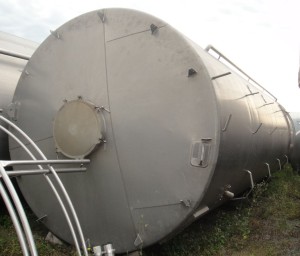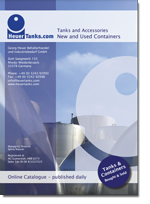Flour silo for foodstuffs
Flour silo
Container 1.000 liters made of V2A, used, isolated
Art.-Nr. M-1966
EUR 3.100,00
add. 19 % VAT excl. shipping costs
Behälter 1.000 Liter aus V2A, gebraucht, isoliert
EUR 3.100,00
add. 19 % VAT excl. shipping costs
Container 1.035 liters made of V4A, unused, single-walled
Art.-Nr. M-2113
EUR 2.320,00
add. 19 % VAT excl. shipping costs
Behälter 1.035 Liter aus V4A, ungebraucht, einwandig
EUR 2.320,00
add. 19 % VAT excl. shipping costs
Silo 30.000 liters made of Aluminium, single-walled, used
Art.-Nr. M-1014
EUR 5.800,00
add. 19 % VAT excl. shipping costs
Silo 30.000 Liter aus Aluminium, einwandig, gebraucht
EUR 5.800,00
add. 19 % VAT excl. shipping costs
Flour silo
Flour silos are used both in the food industry and in milling as well as by large industrial companies. The ground grain is stored in these silos until they undergo further processing.
Flour silos for producers of baked goods
The requirements for producers of foodstuffs are very strict in terms of hygiene standards. These hygiene standards should be observed both in the production of products and when storing primary products. For large-scale bakeries, this means that they will need silos which are suitable for foodstuffs and, in particular, flour.
As many silos are part of a production process, they must also have the necessary equipment. We’ll be happy to help you choose the right silo. We’re also able to modify many tanks found in our catalogue. Simply get in touch, and we’ll be happy to help.
Cleaning flour silos
The production process, i.e. the continual emptying and refilling of the flour silo, can cause product residue to become stuck to different spots in the silo. As the production process generally runs 24 hours a day every day for the whole year, the silos should be cleaned as efficiently and thoroughly as possible. In many large operations with particularly large silos, employees had to climb into the tanks and remove contaminants by hand. There are also easier methods, such as cleaning with water. It is important that, after being cleaned, the silo is only put back into operation once everything is dry. This works best when all hatches are opened and hot water is used for cleaning, as the stainless steel tank will then heat up and dry more easily after being cleaned.












